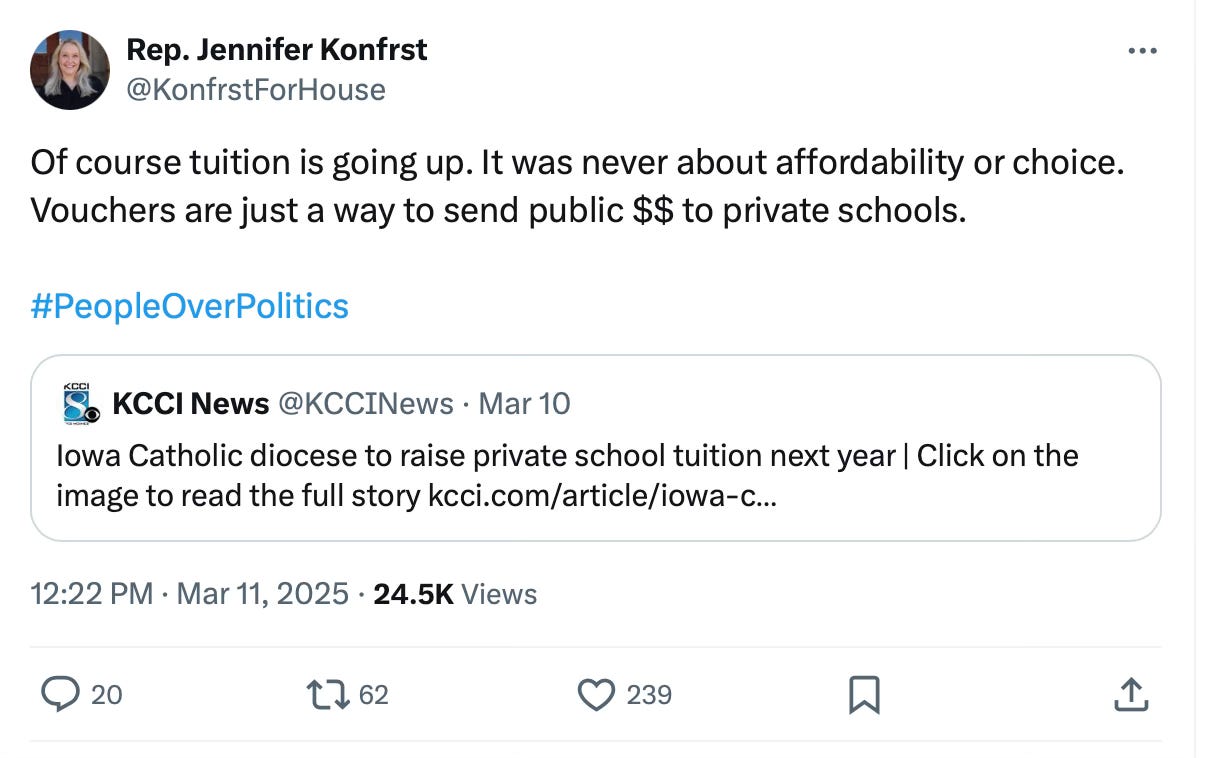Nonpublic School Tuition Increases Are Necessary
Even with tuition increases, Iowa's average nonpublic school tuition lags public school spending per student and teacher salaries.
KCCI reported last week that the Catholic Diocese of Des Moines planned to increase tuition by 10 percent next school year.
This increase is the first phase of several planned tuition increases. Predictably this news coming as education savings accounts (ESAs) are in their second year in Iowa has led school choice opponents to criticize the news.
Iowa House Minority Leader Jennifer Konfrst, D-Windsor Heights, once again picks up the banner of misinformation.
Just a few weeks ago I corrected misinformation she shared on X about ESA funding, I thought I would address her statement here.
First, yes, ESAs (not vouchers) are about affordability and choice. Without ESAs many students could not enroll into a nonpublic school.
Common Sense Institute Iowa found in their analysis of data from the last two school years that between 4,500-5,600 students would not have had access to an accredited nonpublic school of their choice without an ESA.
They also pointed that accredited non-public schools are going to see their primary growth with kindergarteners. This school year there were 32.7 percent more kindergarteners enrolled in an accredited nonpublic school than in the last year before ESAs. Comparatively, just 17.2% more students in grades 1-12 enrolled in a nonpublic school. They predict that ESAs will continue to increase access to school choice for another decade after the initial 3-year phase.
So ESAs were very much about affordability and choice.
Second, nonpublic school’s tuition (which varies widely) have never reflected the true cost of education, and for many schools likely hasn’t kept up with inflation. The average spending per student for public schools including state, local, and federal sources is an average of $16,021 per student, up from the $13,792 figure reported by the U.S. Census Bureau for 2023.
Most nonpublic school tuition has never been in the neighborhood of that kind of spending. Many nonpublic schools, specially elementary schools, offered tuition far less than what ESAs provided.
That isn’t a sustainable model since it means those schools have to fundraise the rest, just to meet operational costs and provide scholarships. This doesn’t touch building campaigns for renovating aging buildings or building new buildings if needed.
Nonpublic schools also lags public schools comparing teacher salaries.
Iowa Association of Christian Schools reported that tuition was increasing among most of their member schools 2 to 5 years ago, and haven’t seen the skyrocketing tuition rates beyond the rate of previous increases.
Third, increasing student enrollment means more teachers with increasingly competitive salaries and more classroom space.
That requires more money.
Also, what State Rep. Konfrst neglected to mention is that many students still qualify for School Tuition Organization (STO) scholarships above their ESAs, and schools still provide private scholarships as well.
But the fact is even with any tuition increase, public school spending per student will far outpace nonpublic school tuition.




